 In a reflection of the growing convergence between phones and digital cameras, Sony Ericsson have declared their new K800 and K790 phones to be worthy of the Cybershot brand.
In a reflection of the growing convergence between phones and digital cameras, Sony Ericsson have declared their new K800 and K790 phones to be worthy of the Cybershot brand.
In line with their photographic aspirations, the two handsets come with integrated 3.2 Megapixel digital cameras offering autofocus, Xenon flash and Sony Ericsson’s BestPic imaging technology.
Taking pictures on the phone is easy. Once you’ve finished yakking, turn the handset on its side, slide the active lens cover downwards and you’ll be presented with a ‘proper’ camera interface, similar to that found in Sony’s Cybershot models.
Using the 2.0″ QVGA 262K TFT display as a viewfinder, users can take advantage of the new BestPic technology, a fancy-pants burst mode which blasts out 9 full-resolution pictures in rapid succession.
Once the shutter is pressed, the camera presents the user with four pictures before and four pictures after the actual image was captured, with the option to scroll through the selection and save the ones that look best.
There’s also an auto red-eye reduction and PictBridge support for shunting your pics direct to a printer.
 To help share your photographic masterpieces, Sony Ericsson have struck a deal with Google to enable easy photo blogging with the search engine’s Blogger service.
To help share your photographic masterpieces, Sony Ericsson have struck a deal with Google to enable easy photo blogging with the search engine’s Blogger service.
Photo storage is taken care of with onboard capacity for 100 pictures and a Memory Stick Micro expansion slot.
Both Cybershot phones come stuffed with useful mobile features, with the dual-mode UMTS/GPRS K800i boasting 3G connectivity with video calling, a stereo FM radio with RDS, Bluetooth 2.0 with stereo audio streaming and USB 2.0 for uploading pics to PCs.
The near-identical K790i knocks a few quid off the price by eschewing the 3G and video, offering tri-band GSM with EDGE connectivity instead.
Other gizmos to be found on both phones include video recording/output, HTML browser, an e-mail client with P-IMAP support; an RSS reader, 3D gaming and a music player with MP3 and AAC support.
Both products will be commercially available in (ahem) ‘Velvet Black’ and start shipping globally during Q2 2006.
 Sony Ericsson have also announced two additions to the K series along with a new phone in the Z range.
Sony Ericsson have also announced two additions to the K series along with a new phone in the Z range.
The K510i comes with a 1.3 megapixel camera phone, Bluetooth, push email and fun imaging effects (whatever they are), while the entry level K310i offers a VGA camera with practical tools for viewing, storing and sharing images.
Finally, the Z530i clamshell camera phone offers a basic feature set including an 0.3 Megapixel camera, music player with MP3/AAC support, Bluetooth, 28 MB of onboard memory, RSS reader and WAP 2.0 browser.
K800 and K790 – Features and specifications
Imaging & Messaging3.2 Mega pixel with Auto Focus Camera
Xenon Flash
BestPic™
Video and image stabilizer function
2.0″ QVGA 262K TFT display
Active lens cover
Photo keys
Cyber-shot™ user interface
Memory for 100 pictures (at 3.2MP), 64 MB internal user memory
Video recording/playback
Adobe picture/video PC SW
16x Digital zoom
Auto red eye reduction
DPOF & PictBridge
Time line view of pictures
Picture Blogging (powered by Blogger)
PictureDJ ™ and VideoDJ
Standard push e-mail (P-IMAP) support
VGA camera for Video Telephony (no VGA camera in K790)
 EntertainmentMusic Player (MP3, AAC, AAC+, eAAC+ support)
EntertainmentMusic Player (MP3, AAC, AAC+, eAAC+ support)
Video Player
Music DJ™
OMA DRM phase 1.x
Streaming Audio/Video
3D games
A/B buttons for horizontal games support
RDS FM radio
ConnectivityBluetooth® 2.0
IrDA
HTML Full Browser with RSS readers
USB 2.0 Mass storage
External antenna connector
Memory Stick Micro (M2) slot
Flight mode
Multitasking
USB cable, stereo portable handsfree and PC software in the box
Talk time: up to 7 hours GSM/2.5 hours UMTS
Standby time: up to 350 hours
Size: 106 x 47 x 18 (22) mm
Weight: 115 grams
Sony Ericsson
 Big glasses-toting Buggles sang about ‘Video Killing The Radio Star’ back in 1979, but new figures from Ofcom suggest that the while Internet may not exactly be killing TV, it’s certainly giving it a bit of a duffing behind the bike sheds.
Big glasses-toting Buggles sang about ‘Video Killing The Radio Star’ back in 1979, but new figures from Ofcom suggest that the while Internet may not exactly be killing TV, it’s certainly giving it a bit of a duffing behind the bike sheds. Industry pundits are collaring the Internet as the reason for this decline, along with DVDs and gaming.
Industry pundits are collaring the Internet as the reason for this decline, along with DVDs and gaming. Consumer broadband continues its exponential growth, exploding from zero to 10 million connections in just over seven years, with some 70,000 new connections being added per week.
Consumer broadband continues its exponential growth, exploding from zero to 10 million connections in just over seven years, with some 70,000 new connections being added per week. The English version of Wikipedia has now notched up more than one million articles, according to the Wikimedia Foundation, the fellas who run the free online encyclopedia.
The English version of Wikipedia has now notched up more than one million articles, according to the Wikimedia Foundation, the fellas who run the free online encyclopedia. Wikipedia’s reach is truly global, with versions of the encyclopaedia currently available in 125 languages, containing a total of 3.3 million articles.
Wikipedia’s reach is truly global, with versions of the encyclopaedia currently available in 125 languages, containing a total of 3.3 million articles. With the million-article mark passed and the Wikimedia Foundation estimating that new articles are coming in at a rate of 1,700 new articles every day, our back-of-a-beer-mat calculation reckons they’ll be hitting 2 million sometime 2009.
With the million-article mark passed and the Wikimedia Foundation estimating that new articles are coming in at a rate of 1,700 new articles every day, our back-of-a-beer-mat calculation reckons they’ll be hitting 2 million sometime 2009. Vodafone’s new high end 904SH (Sharp 904) 3G handset may look like any other twisty clamshell phone, but it has a cunning twist or two lurking inside its attractive, squared off lines.
Vodafone’s new high end 904SH (Sharp 904) 3G handset may look like any other twisty clamshell phone, but it has a cunning twist or two lurking inside its attractive, squared off lines.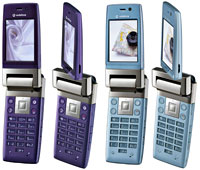 If it likes what it sees, it will ask for the answer to secret question (already inputted), and if that’s correct the phone will be ready for use. Vodafone say the whole validation process should take less than a second.
If it likes what it sees, it will ask for the answer to secret question (already inputted), and if that’s correct the phone will be ready for use. Vodafone say the whole validation process should take less than a second.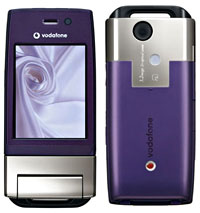 Back to the phone itself, the design uses a smart flip and swivel screen with the large screen packing in a massive VGA display – that’s 480×640 pixels, the same resolution as old 14″ monitors!
Back to the phone itself, the design uses a smart flip and swivel screen with the large screen packing in a massive VGA display – that’s 480×640 pixels, the same resolution as old 14″ monitors! With all that gadgetry inside it’s not surprising to find that the 904 is a bit of a pocket bulging beast, measuring 104 x 50 x 28mm and weighing 151 grams.
With all that gadgetry inside it’s not surprising to find that the 904 is a bit of a pocket bulging beast, measuring 104 x 50 x 28mm and weighing 151 grams.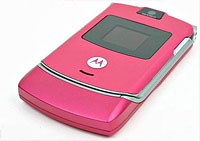 The Big Six handset suppliers increased their rottweiler-like grip on the global mobile phone market, accounting for 84 per cent of all sales in Q4 2005.
The Big Six handset suppliers increased their rottweiler-like grip on the global mobile phone market, accounting for 84 per cent of all sales in Q4 2005.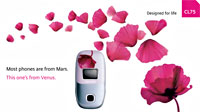 There was a veritable tango of phone flogging going down Latin America way, with sales reaching nearly 102 million units in 2005, a maraca-shaking 40 percent increase from 2004.
There was a veritable tango of phone flogging going down Latin America way, with sales reaching nearly 102 million units in 2005, a maraca-shaking 40 percent increase from 2004.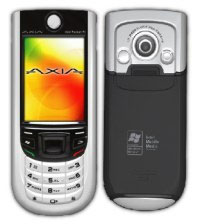 Fifth Media have announced the forthcoming unveiling of their AXIA A308 PDA Phone, proudly proclaimed as the (deep breath), “world’s smallest PDA Phone on Microsoft Windows Mobile 5 featuring Wi-Fi connectivity.”
Fifth Media have announced the forthcoming unveiling of their AXIA A308 PDA Phone, proudly proclaimed as the (deep breath), “world’s smallest PDA Phone on Microsoft Windows Mobile 5 featuring Wi-Fi connectivity.”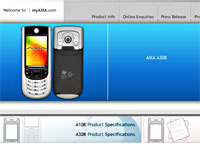 The all-important battery life is claimed at 4 hours talktime with the removable/rechargeable 1500mAh Li-Polymer offering 120 hours of standby time.
The all-important battery life is claimed at 4 hours talktime with the removable/rechargeable 1500mAh Li-Polymer offering 120 hours of standby time.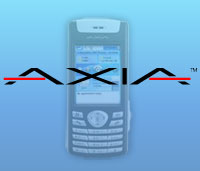 Quad-band GSM (850/900/1800/1900 MHz)
Quad-band GSM (850/900/1800/1900 MHz) With a multitude of third party manufacturers making a mint from a multiplicity of iPod accessories, Apple has decided to cut itself a slice of the action with their own high-end Apple iPod Hi-Fi speaker system.
With a multitude of third party manufacturers making a mint from a multiplicity of iPod accessories, Apple has decided to cut itself a slice of the action with their own high-end Apple iPod Hi-Fi speaker system.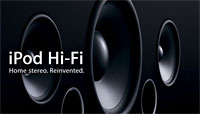 With portability in mind, the iPod Hi-Fi features big handles on either side (but no central grip which is a bit odd).
With portability in mind, the iPod Hi-Fi features big handles on either side (but no central grip which is a bit odd).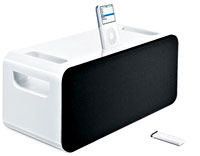 That shiny finish looks a bit scratchable to us too and we can’t imagine many death metal loving teenagers wanting a great big white box in their satanic bedrooms either.
That shiny finish looks a bit scratchable to us too and we can’t imagine many death metal loving teenagers wanting a great big white box in their satanic bedrooms either. Mind you, Steve Jobs was suitably enthusiastic, declaring it as the, “home stereo reinvented for the iPod age”.
Mind you, Steve Jobs was suitably enthusiastic, declaring it as the, “home stereo reinvented for the iPod age”. Microsoft has unveiled the official line up of the Windows Vista packages, with no less than six versions being available, all in 32 and 64-bit flavours.
Microsoft has unveiled the official line up of the Windows Vista packages, with no less than six versions being available, all in 32 and 64-bit flavours. All versions of the new OS will come with Internet Explorer 7.0, Vista desktop search, parental controls and Windows Defender anti-spyware technology.
All versions of the new OS will come with Internet Explorer 7.0, Vista desktop search, parental controls and Windows Defender anti-spyware technology.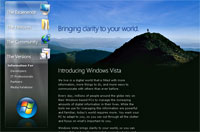 The super-slick redesigned Windows Aero GIO promises to provide a ‘transparent glass’ design, with subtle effects such as dynamic reflections and smooth animations, along with Windows Flip and Flip 3D desktop navigation features.
The super-slick redesigned Windows Aero GIO promises to provide a ‘transparent glass’ design, with subtle effects such as dynamic reflections and smooth animations, along with Windows Flip and Flip 3D desktop navigation features.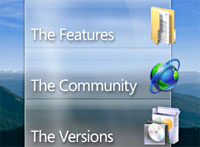 All versions of Windows Vista are scheduled to be broadly available in the second half of 2006, with pricing to be announced.
All versions of Windows Vista are scheduled to be broadly available in the second half of 2006, with pricing to be announced.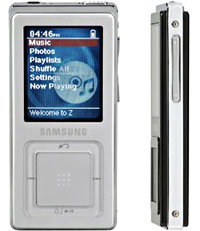 Due to hit the shelves in March, Samsung Electronics’ new YP-Z5 MP3 player is causing a stir because it was designed by Paul Mercer – the very same programming genius who created the interface for Apple’s runaway success, the iPod.
Due to hit the shelves in March, Samsung Electronics’ new YP-Z5 MP3 player is causing a stir because it was designed by Paul Mercer – the very same programming genius who created the interface for Apple’s runaway success, the iPod. At $199 (~e167, ~£113) to $249 the pricing is similar Apple’s product, and – crucially – Samsung is promising a seamless connection between player and download service via Microsoft’s PlaysForSure digital music standard.”
At $199 (~e167, ~£113) to $249 the pricing is similar Apple’s product, and – crucially – Samsung is promising a seamless connection between player and download service via Microsoft’s PlaysForSure digital music standard.”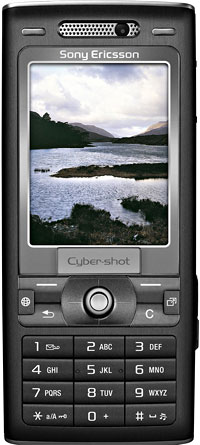 In a reflection of the growing convergence between phones and digital cameras, Sony Ericsson have declared their new K800 and K790 phones to be worthy of the Cybershot brand.
In a reflection of the growing convergence between phones and digital cameras, Sony Ericsson have declared their new K800 and K790 phones to be worthy of the Cybershot brand.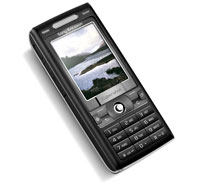 To help share your photographic masterpieces, Sony Ericsson have struck a deal with Google to enable easy photo blogging with the search engine’s Blogger service.
To help share your photographic masterpieces, Sony Ericsson have struck a deal with Google to enable easy photo blogging with the search engine’s Blogger service. Sony Ericsson have also announced two additions to the K series along with a new phone in the Z range.
Sony Ericsson have also announced two additions to the K series along with a new phone in the Z range.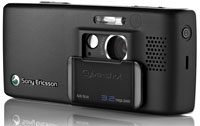 EntertainmentMusic Player (MP3, AAC, AAC+, eAAC+ support)
EntertainmentMusic Player (MP3, AAC, AAC+, eAAC+ support) More flexible than a Russian athlete in a vat of oil, Samsung’s double-flipping DMB phone offers a novel twist on the clamshell format.
More flexible than a Russian athlete in a vat of oil, Samsung’s double-flipping DMB phone offers a novel twist on the clamshell format.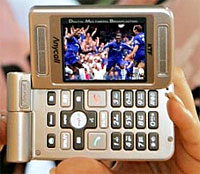 As well as the DMB functionality, the Samsung SPH-B1300 serves up the usual advanced mobile feature set, complete with a two megapixel digital camera and built-in MP3 player.
As well as the DMB functionality, the Samsung SPH-B1300 serves up the usual advanced mobile feature set, complete with a two megapixel digital camera and built-in MP3 player. We can expect more details about the Samsung SPH-B1300 to be revealed at the CeBit 2006 show in Hannover next month.
We can expect more details about the Samsung SPH-B1300 to be revealed at the CeBit 2006 show in Hannover next month.